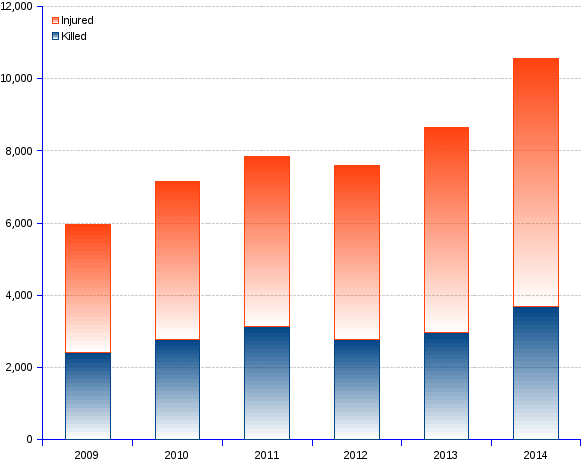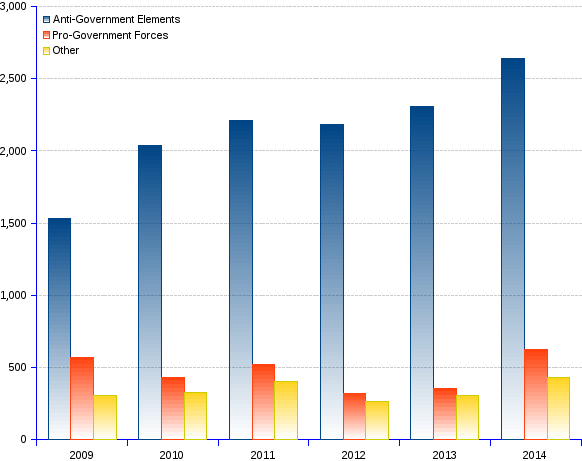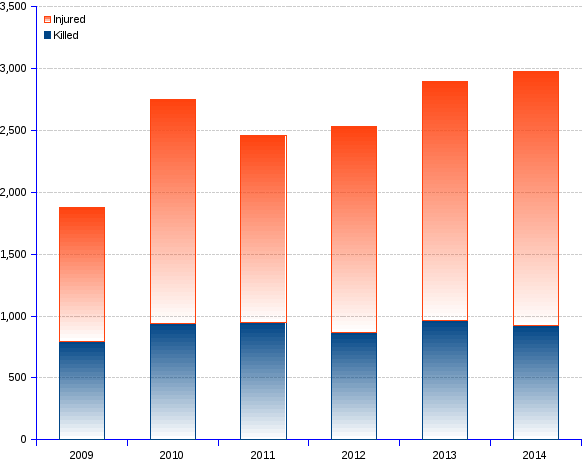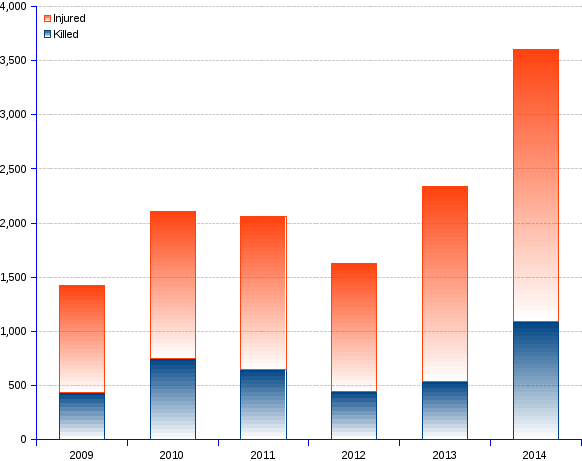![]() Afghan Civilian Casualties 2009-2014 : Civilians killed and injured | Civilian deaths by parties to the conflict | Civilian casualties by IEDs | Civilian casualties by ground engagements |
Afghan Civilian Casualties 2009-2014 : Civilians killed and injured | Civilian deaths by parties to the conflict | Civilian casualties by IEDs | Civilian casualties by ground engagements |

 Check also reported Afghan casualties for the period 2007-2012
Check also reported Afghan casualties for the period 2007-2012
Despite whatever is said about the military being a risky job, civilians are the most vulnerable to the hazards of war, in Afghanistan and elsewhere. During the whole formal duration of the Afghan war, from October 2001 through December 2014, the NATO/ISAF forces suffered a total of 3,485 deaths, and 20,067 US military were wounded in action. During the much shorter period since January 2009, 17,774 Afghan civilians lost their lives, and 29,971 have been injured. These numbers are reported by UNAMA (United Nations Assistance Mission in Afghanistan) who cautiously warn that they "may be under-reporting civilian casualties given limitations inherent in the operating environment."
Children and women have not been spared. In 2013, UNAMA documented 1,764 children casualties (564 children killed and 1,200 injured) or 20 percent of the total civilian casualties. In 2014, they documented a total of 2,474 children casualties (714 killed and 1,760 injured), the highest number recorded since 2009, or 23.5 percent of the total civilian casualties.
Women's percentage of the total civilian casualties is far lower than children's — around 9 percent in both 2013 and 2014. In 2013, UNAMA documented 750 women casualties (236 killed and 514 injured), and in 2014, 909 women casualties (298 deaths and 611 injured). Although the UN Resolution 1386 (2001), authorizing the establishment of ISAF, stressed the obligation of the forces to strictly observe the "human rights law, including respect for the rights of women", Afghan women have also been wronged otherwise. Women have been often left as sole income-providers for their households after the death or injury of their husbands, experiencing dire social and economic consequences, with poverty forcing many of them to give their daughters in marriage in exchange for debts or to take their children out of school to work. Widowed women have often been subjected to other forms of violence and abuse from family and community members.
Reporting on casualties of Afghan civilians and security forces did not begin until 2007, and UNAMA track civilian casualties only since 2009. The belated interest for the civilian side of the war reveals the limited care, respect and consideration shown to civilian populations, especially when these populations have dark pigmented skins, and are supposed to be eager to receive the blessings of western CDH (civilization, democracy and human-rights).
Warfare is pitiless for civilians nowadays. Whether in Europe (Ukraine), Africa (Congo D.R., Somalia, Libya, Nigeria, Niger,...), Middle East (Syria, Iraq, Palestine) or Central Asia (Afghanistan, Pakistan), non-combatant civilians are far more exposed to, and suffer far more intensely from the miseries of war than combatant elements. Brutal violence against civilians is rooted in our common history. Attila, Timur Khan, the "écorcheurs" of the 100-year war, the marauding soldiers of the 30-year war, the perpetrators of the Nanjing massacre, or of the Guernica and the Dresden bombardments, all made a name for themselves in the business of making war by terrorizing civilian, non-combatant populations. The barbaric, ruthless and callous behavior of combatants towards civilians, including women and children, in Afghanistan or elsewhere should not come as a surprise.
The novelty is the accomplished 20th century use of sophisticated methods of camouflaging the horrors of war by means of what we may call "lawphemism", a stratagem that combines the comforting imprint of positive law, and the soothing efficacy of euphemism, that is the substitution of a mild, deflected expression to a blunt, candid one.
The power of euphemism as a thought-control tool has been known and explored since mankind started making persuasive speeches. This art has been raised to a higher degree in the 20th century. The linguist Victor Klemperer studied the language of the 3rd Reich (1) showing how the regime manipulated it in order to defuse the ugliness of certain concepts (e.g. Konzertlager instead of Konzentrationslager, for concentration camp), and to heighten the people's sense of belongingness (e.g. by reiterating the word Volk, for people: Volksgemeinschaft, Volksfeiertag, Volksfest, Volksfremd). Orwell (2) fictionalized the methodical tampering with language by a totalitarian state, by means of the "Newspeak" (e.g. "unperson": one who has not only been killed, but effectively erased from existence; "joycamp": forced labor camp; "vaporized": having all records of one's existence erased), and of the "Doublethink", which allows simultaneously holding contradictory thoughts (e.g. Ignorance is Strength, Freedom is Slavery, War is Peace). Marcuse (3) described how the powers that be make themselves immune against the expression of protest and refusal by similar linguistic processes (e.g. "clean bomb", "harmless atomic fall-out", "Freedom Academy of cold war specialists").
Since the launching in 2001 of the so-called "Global War on Terror", itself a euphemism for illegal war against everybody, everywhere, the United States took the Newspeak discipline to a higher stage of accomplishment, by moving from the politically-correct to the juridically-correct level — what we call a "lawphemism", or a euphemism securing the strict adherence to the letter rather than the spirit of the law. International Humanitarian Law (IHL), and most national laws, strictly forbid behaviors such as direct attacks by belligerents on civilians or civilian targets, and impose stringent criteria on killings, arrests, detentions of, and violence against individuals by state agents. US legal advisors devised easy ways to circumvent these restrictions. According to positive law, a crime is what the law specifically identifies as such, therefore it suffices to substitute new words to those stipulated in the law to elude the problem. Substituting "imminent risk", or "self-defense", or "preemptive war" to unilateral aggression; "killing of lawful wartime targets" or "targeted killing" to premeditated murder; "enhanced interrogation" to torture; "black site" to illegal detention facility; "enemy combatant" to enemy soldier, all these are "lawphemisms" that provide US agents with plenty of lee way to execute criminal acts without violating the letter of the law. Similarly, in the case of direct attacks against civilians, in order to escape charges of war crimes, US agents speak of "surgical strikes" and of "signature strikes" that may unfortunately cause "collateral damages". In other words, bad luck!
Tragically, the gimmick works. Sad to say, the man in the street feels genuinely distraught after watching the news of the latest massacre committed by a deranged assailant against students in the Santa Monica College, Cal. USA, causing 6 deaths (June 7, 2013), but he does not shudder in learning that a US drone strike killed "6-14", injured "4", including men who were digging out bodies at the site of a previous strike, in North Waziristan (June 12, 2014). The bare fact that the count of casualties is accurate to the unit in one instance, and provided as a range in the other, suggests that the lives of the latter do not matter much — a couple of locals more or less, who cares?
Afghanistan War | ||||
Year | Killed | Injured | Total | Year-on-year change |
| 2009 | 2,412 | 3,556 | 5,968 | |
| 2010 | 2,792 | 4,368 | 7,160 | 20.0% |
| 2011 | 3,133 | 4,709 | 7,842 | 9.5% |
| 2012 | 2,769 | 4,821 | 7,590 | -3.2% |
| 2013 | 2,969 | 5,668 | 8,637 | 13.8% |
| 2014 | 3,699 | 6,849 | 10,548 | 22.1% |
| Total 2009-2014 | 17,774 | 29,971 | 47,745 | |

![]() Afghan Civilian Casualties 2009-2014 : Civilians killed and injured | Civilian deaths by parties to the conflict | Civilian casualties by IEDs | Civilian casualties by ground engagements |
Afghan Civilian Casualties 2009-2014 : Civilians killed and injured | Civilian deaths by parties to the conflict | Civilian casualties by IEDs | Civilian casualties by ground engagements |

The year 2014 has been especially harsh for Afghan civilians, their number of deaths having grown up to 3,699 or 25 percent more than in 2013. As the war approached its unilaterally (by NATO/ISAF only) proclaimed closure, belligerence on the ground became grimmer and more unrelentingly severe for civilians.
UNAMA attributed 73 percent of all civilian fatalities since 2009 to Anti-Government Elements, 16 percent to Pro-Government Forces, and 12 percent to ground engagements between Anti-Government Elements and Afghan national security forces in which a civilian casualty could not be attributed to a specific party.
It is spine-chilling to realize that insurgents, mostly Afghans themselves, could be responsible for 73 percent of Afghan civilian deaths. It is a stark indictment on their savagery, an indictment that should fill everyone with revulsion. However, we the westerners, boastful of our own humane, high moral standards, do not have to feel accountable for what insurgents do — only, and fully, for what NATO/ISAF forces and allies do in our name. Although the latter's share of civilian killing is 16 percent "only", this still is way too much. We should not tolerate under no circumstances that our tax money is misdirected, and spent on harming civilian lives and property.
Afghanistan War | |||||
Year | AGE ¹ | PGF ² | Other ³ | Total | Year-on-year change |
| 2009 | 1,533 | 573 | 306 | 2,412 | |
| 2010 | 2,037 | 429 | 326 | 2,792 | 15.8% |
| 2011 | 2,208 | 519 | 406 | 3,133 | 12.2% |
| 2012 | 2,180 | 324 | 265 | 2,769 | -11.6% |
| 2013 | 2,310 | 354 | 305 | 2,969 | 7.2% |
| 2014 | 2,643 | 622 | 434 | 3,699 | 24.6% |
| Total 2009-2014 | 12,911 | 2,821 | 2,042 | 17,774 | |
| Percent of total | 72.6% | 15.9% | 11.5% | 100% | |
| ¹ AGE or Anti-Government Elements: all individuals and armed groups involved in armed conflict with or armed opposition against the Government of Afghanistan and/or international military forces. They include those who identify as Taliban as well as individuals and non-State organized armed groups taking a direct part in hostilities and assuming a variety of labels including the Haqqani Network, Hezb-e-Islami, Islamic Movement of Uzbekistan, Islamic Jihad Union, Lashkari Tayyiba, Jaysh Muhammed, and other militia and armed groups pursuing political, ideological or economic objectives including armed criminal groups directly engaged in hostile acts on behalf a party to the conflict. ² PGF or Pro-Government Forces: Afghan Government National Security Forces and other forces and groups that act in military or paramilitary counter-insurgency operations and are directly or indirectly under the control of the Government of Afghanistan. These forces include, but are not limited to, the Afghan National Army, Afghan Police and Government local defense forces, and also include international military forces and other foreign intelligence and security forces. ³ Other: Casualties from incidents for which responsibility cannot be determined with any degree of certainty. | |||||

![]() Afghan Civilian Casualties 2009-2014 : Civilians killed and injured | Civilian deaths by parties to the conflict | Civilian casualties by IEDs | Civilian casualties by ground engagements |
Afghan Civilian Casualties 2009-2014 : Civilians killed and injured | Civilian deaths by parties to the conflict | Civilian casualties by IEDs | Civilian casualties by ground engagements |

IEDs (improvised explosive devices) are the hallmark of the Afghan war. Highly effective against NATO/ISAF forces, both directly, by the number of casualties caused (50.4 percent of all casualties, 2001-2014), and indirectly, by the huge costs that US and ISAF forces incurred in developing ever-elusive anti-IED protection devices, they remained a major threat also for civilians throughout Afghanistan. In 2014, UNAMA documented 2,978 civilian casualties (925 killed and 2,053 injured) from IEDs, up three percent from 2013.
Roughly one third of all civilian casualties (of which 30.6% killed, 33.5% injured) fell victim of IEDs. Remote-controlled IEDs caused the most harm to civilians from IEDs with 1,119 civilian casualties (234 deaths and 885 injured). Civilian deaths and injuries from magnetic-IEDs more than doubled in 2014, with 241 civilian casualties (20 deaths and 221 injured) documented, up 136 percent from 2013. The majority of these incidents involved Anti-Government Elements placing magnetic-IEDs on vehicles of Afghan security forces, often with terrible consequences for civilians in the areas where these IEDs were detonated.
IEDs are the typical killing system of the poor man. It is likely that Afghan insurgents, if offered the choice, would prefer to have at their disposal the full NATO/ISAF arsenal of sophisticated weaponry and personnel, including modern bomber and fighter aircrafts, attack helicopters, missile launching drones, multiple-launch rocket systems, infantry fighting vehicles, the whole paraphernalia of electronic surveillance, detection and scrambling, etc. But that is not an option. They must rely instead on moving around on foot, engaging with small arms, mortars and rockets, and fighting with homemade IEDs. For all their operational and cost advantages, IEDs remain indiscriminate and blind: they cannot tell friend from enemy, nor military from civilian. They are also time-free: they may be forgotten, remain hidden, and strike the innocent passerby, long afterwards. That is the horror of this kind of weapon, making the ghastly Afghan war all the more criminal.
Afghanistan War | ||||
Year | Killed | Injured | Total | Year-on-year change |
| 2009 | 796 | 1,081 | 1,877 | |
| 2010 | 940 | 1,806 | 2,746 | 46.3% |
| 2011 | 949 | 1,511 | 2,460 | -10.4% |
| 2012 | 868 | 1,663 | 2,531 | 2.9% |
| 2013 | 964 | 1,928 | 2,892 | 14.3% |
| 2014 | 925 | 2,053 | 2,978 | 3.0% |
| Total 2009-2014 | 5,442 | 10,042 | 15,484 | |
| As percent of total civilian casualties | 30.6% | 33.5% | 32.4% | |
| ¹ IED or Improvised Explosive Device. A bomb constructed from locally available or unassuming materials. | ||||

![]() Afghan Civilian Casualties 2009-2014 : Civilians killed and injured | Civilian deaths by parties to the conflict | Civilian casualties by IEDs | Civilian casualties by ground engagements |
Afghan Civilian Casualties 2009-2014 : Civilians killed and injured | Civilian deaths by parties to the conflict | Civilian casualties by IEDs | Civilian casualties by ground engagements |

UNAMA investigators found that ground engagements have been the leading cause of civilian casualties in Afghanistan, accounting for 22.0% of all Afghan civilians killed, 30.9% of all civilians injured, and overall for 27.6% of all civilian casualties for the period 2009 to 2014.
Quoting from the UNAMA report (see source below), the 22 percent rise in civilian casualties in 2014 resulted mainly from increased ground engagements across Afghanistan in which parties to the conflict also increasingly used high explosive weapons systems, such as mortars, rockets and grenades in civilian-populated areas — with devastating consequences for civilians. In 2014, civilian deaths and injuries from ground engagements increased by 54 percent compared to 2013 making them the leading cause of civilian casualties and the biggest killers of women and children in 2014.
As the withdrawal of international military forces and combat air support continued in 2014, UNAMA observed more frequent and larger ground operations by both Afghan national security forces and Anti-Government Elements. UNAMA documented 3,605 civilian casualties (1,092 killed and 2,513 injured) from ground engagements, a 54 percent increase from 2013, accounting for 34 percent of all civilian casualties in 2014. These civilian deaths and injuries were caused when civilians were caught in crossfire between insurgents and Afghan security forces fighting in and around civilian-populated areas.
These facts fly in the face of NATO war strategists, who try to shake responsibility away by putting forward their technology-doped, high-accuracy weaponry systems, allegedly capable of striking military targets with maximum impact, while minimizing civilian "collateral damages". What a pitiful alibi! Military operations abroad entail either massive air bombings, or ground engagements, or both. In either case, civilian bystanders are always the most victimized, and no human-rightist rhetoric will ever change that.
Afghanistan War | ||||
Year | Killed | Injured | Total | Year-on-year change |
| 2009 | 438 | 991 | 1,429 | |
| 2010 | 750 | 1,360 | 2,110 | 47.7% |
| 2011 | 647 | 1,415 | 2,062 | -2.3% |
| 2012 | 445 | 1,187 | 1,632 | -20.9% |
| 2013 | 537 | 1,797 | 2,334 | 43.0% |
| 2014 | 1,092 | 2,513 | 3,605 | 54.5% |
| Total 2009-2014 | 3,909 | 9,263 | 13,172 | |
| As percent of total civilian casualties | 22.0% | 30.9% | 27.6% | |
| ¹ Ground engagements include attacks or operations in which small arms, heavy weapons or area weapons systems, i.e. mortars and rockets are fired. | ||||
Source: United Nations Assistance Mission in Afghanistan (UNAMA), Afghanistan Annual Report 2014 - Protection Of Civilians In Armed Conflict, February 2015.